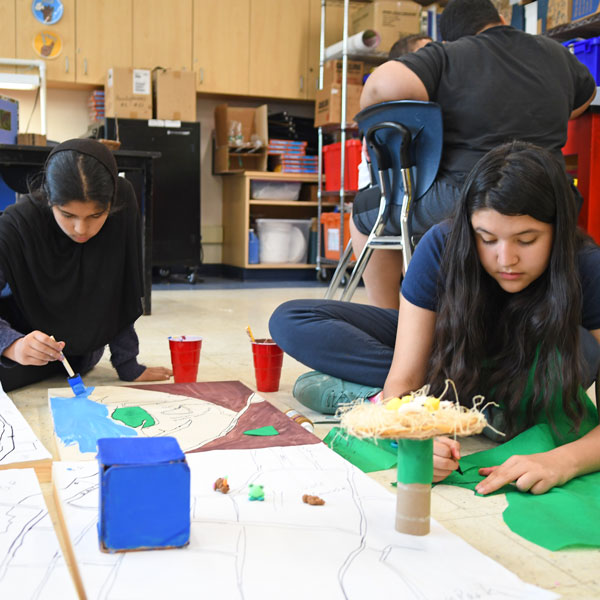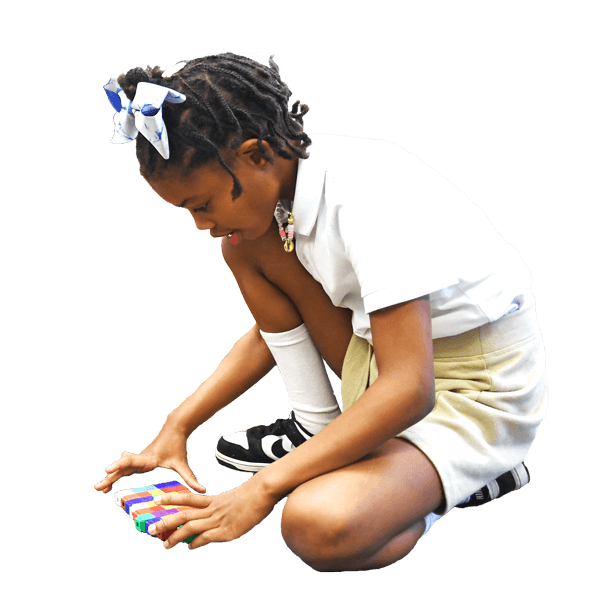Not all play is created equal. Here’s what research actually says.
Despite decades of evidence, misconceptions about play-based learning prevent districts, schools, and individual educators from embracing this proven approach. Let’s separate fact from fiction.
Myth 1: “If kids are talking to one another, having fun and laughing, they’re not learning”
Fact: Young brains require active, hands-on and social experiences to build lasting knowledge. Joyful engagement strengthens memory formation and creates positive associations with learning that last for years.
Myth 2: “There’s no time for play because I have a lot of reading and math fundamentals before students move to the next grade”
Fact: Literacy and math don’t have to be taught solely through direct instruction; in fact, play-based learning will likely have young students grasping and recalling foundational skills better because they are able to apply what they are learning in an active, engaged and meaningful way rather than isolated worksheets, drills or direct instruction.
Myth 3: “All play is created equal”
Fact: Both free play and play-based learning have benefits for children’s development and wellbeing, offering opportunities for socialization and building executive functioning skills. Play-based learning delivers additional benefits by encouraging students to be curious and engage in the curriculum in meaningful ways. A key difference between these two forms of play is that in play-based learning, teachers have a plan for the content and skills they want children to learn.
Learn the Critical Differences
Myth 4: “Play-based learning only works for young children”
Fact: Play-based learning is an intentional approach to teaching that engages students well beyond the early school years. Brain development and best practices tell us that students of all ages are more likely to succeed when teachers meet them at their level of understanding and scaffold them to the next level by giving students opportunities to apply what they are learning in real-world scenarios—an essential tenant of play-based learning.
Myth 5: “Test scores will suffer”
Fact: Longitudinal research shows that play-based learners have better long-term academic success than students who received traditional academic instruction. Play-based learners achieve higher graduation rates and are more likely to become contributing members of society, in addition to scoring better on tests. In the long run, we are preparing kids to not only problem solve, but also identify problems before they occur–play does this, test taking does not.
Myth 6: “Play-based classrooms need special materials and a lot of space”
Fact: Children don’t require special supplies or settings to play or to learn. The most powerful learning often uses simple materials. Cardboard, recycled containers, and natural objects spark creativity and inquiry without breaking the bank. Especially in later elementary school, students use the same simple materials that they would use in any classroom (pens, pencils, paper)—or none at all.
Myth 7: “English Language Learners need only direct instruction”
Fact: The majority of the recommended strategies for ELL instruction align with a play-based learning pedagogy far better than a direct teaching. Play-based learning provides authentic, culturally responsive contexts that support language development, help ELL students feel welcome and safe, and contribute to the classroom.
Myth 8: “Students won’t be prepared for real-world demands”
Fact: Play-based learning develops collaboration, creativity, critical thinking, and adaptability—exactly the skills employers value most in the modern economy.
Bottom Line
Play-based learning delivers rigorous, standards-aligned education that:
- Improves academic outcomes measurably
- Works across all elementary grades effectively (and can be used as a teaching tool well beyond, too)
- Requires teachers to be respected as skilled professionals to be trusted with a measure of autonomy while following the curriculum
- Prepares students for future success comprehensively
- Can work within existing curriculum, and work in any school
Next Steps:
Play-Based Learning Myths:
Fact vs. Fiction
Not all play is created equal. Here’s what research actually says.
Despite decades of evidence, misconceptions about play-based learning prevent districts, schools, and individual educators from embracing this proven approach. Let’s separate fact from fiction.

Challenging the MythsAbout Play-Based Learning
Even with decades of research, myths about play-based learning persist. Too often, play is dismissed as an “add-on” to the school day or lacking rigor. In fact, play-based learning boosts academic achievement, fosters social development, and prepares students for lasting success.
MYTH: “If kids are talking to one another, having fun and laughing, they’re not learning.”
FACT: Young brains require active, hands-on and social experiences to build lasting knowledge. Children learn, retain and transfer skills and knowledge much better when their classroom environments encourage active and meaningful engagement with the material and their peers.
MYTH: “There’s no time for play because I have a lot of reading and math fundamentals before students move to the next grade.”
FACT: Literacy and math don’t have to be taught solely through direct instruction. In fact, early elementary school students in play-based learning classrooms grasp and recall foundational skills better than direct instruction classrooms because they are able to apply what they are learning in an active, engaged and meaningful way rather than isolated worksheets, drills or direct instruction.
MYTH: “All play is created equal.”
FACT: Both free play and play-based learning have benefits for children’s development and wellbeing, offering opportunities for socialization and building executive functioning skills. Play-based learning delivers additional benefits for students’ academic success because it encourages students to be curious and engage in the curriculum in meaningful ways. What separates play-based learning from free play (other than being a comprehensive teaching approach) is that teachers have guiding goals and a plan for the content and skills they want children to learn.
MYTH: “Play-based learning only works for young children.”
FACT: Play-based learning is an intentional approach to teaching that engages students well beyond the early school years. Brain development and best practices tell us that students of all ages are more likely to succeed when teachers meet them at their level of understanding and scaffold them to the next level by giving students opportunities to apply what they are learning in real-world scenarios—an essential tenet of play-based learning.
MYTH: “Test scores will suffer.”
FACT:Longitudinal research shows that play-based learners have better long-term academic success than students who received traditional academic instruction. Play-based learners achieve higher graduation rates and are more likely to become contributing members of society, in addition to scoring better on tests. In the long run, we are preparing kids for life well beyond test taking; we need to cultivate learners (and adults) who not only problem solve, but also identify problems before they occur. The way we get to better outcomes is through play-based learning.
MYTH: “Play-based classrooms need special materials and a lot of space.”
FACT:Children don’t require special supplies or settings to play or to learn. The most powerful learning often has students engaging with simple, open-ended materials. Cardboard, recycled containers, and natural objects spark creativity and inquiry without breaking the bank. Especially in later elementary school, students use the same basic materials that they would use in any classroom (pens, pencils, paper), or none at all.
MYTH: “English Language Learners need only direct instruction.”
FACT: The majority of the recommended strategies for ELL instruction align with a play-based learning pedagogy far better than a direct teaching. Play-based learning provides authentic, culturally responsive contexts that support language development, help ELL students feel welcome and safe, and contribute to the classroom.
MYTH: “Students won’t be prepared for real-world demands.”
FACT: Play-based learning develops collaboration, creativity, critical thinking, and adaptability—exactly the skills employers value most in the modern economy.

Bottom Line
Play-based learning delivers rigorous, standards-aligned education that:
- Improves academic outcomes measurably
- Works across all elementary grades effectively (and can be used as a teaching tool well beyond, too)
- Requires that teachers be trusted as skilled professionals and be allowed a measure of autonomy while following the curriculum and meeting standards
- Prepares well-rounded students for future success in school and adulthood
- Can work within existing curriculum, and work in any school